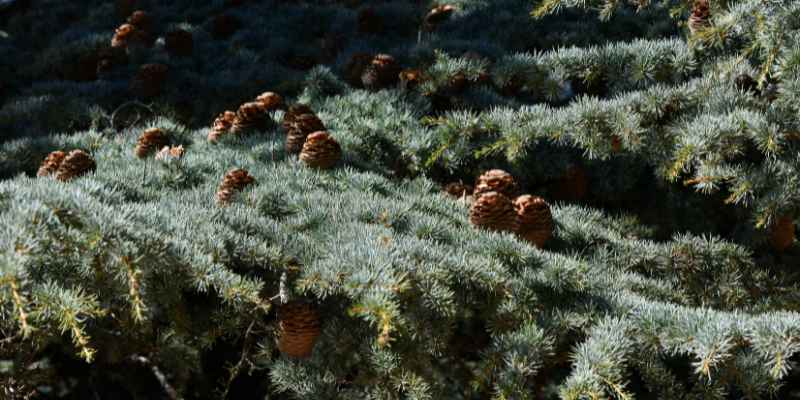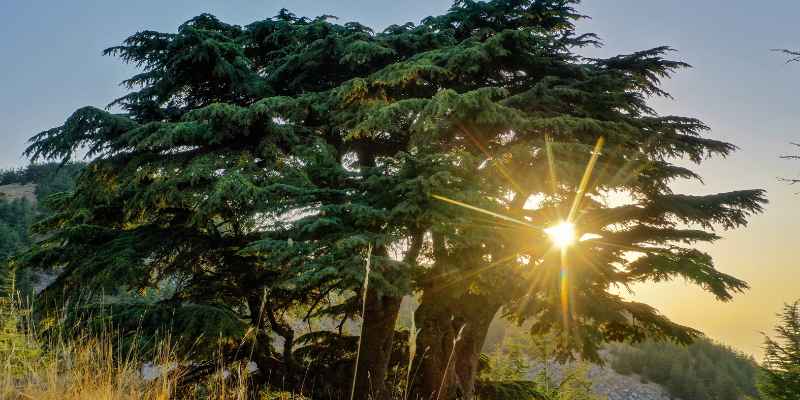Cedar trees can be found in various locations such as Austin, Texas, United States. They are also commonly found in the Mediterranean region, Western Europe, southern Australia and New Zealand, and southern and western North America.
Eastern red cedar trees, which produce durable wood, can be found along the East Coast of the United States, stretching as far west as Nebraska. They are often used in furniture, flooring, and siding. Cedar trees, specifically the Eastern Red Cedar Tree, can grow in the wilds of North America, from the eastern seaboard to Texas and as far north as South Dakota.
When selecting a location for cedar tree planting, it is important to choose a spot with at least six hours of sunlight per day and avoid areas prone to flooding.
Cedar Trees: A Global Perspective
Cedar trees, with their majestic beauty and versatile uses, can be found in various regions around the world. From the towering True Cedars to the diverse species beyond, these trees have captured the fascination of many. Let’s explore the global presence of cedar trees and where you can find them.
The True Cedars: Origins And Classification
True Cedars, belonging to the Cedrus genus, have their origins in the Mediterranean region and parts of Western Asia. These iconic trees are known for their aromatic wood and conical shape, adding a touch of elegance to landscapes.
Cedar Trees Beyond The ‘true’ Species
While True Cedars dominate discussions, other cedar species like the Eastern Red Cedar (Juniperus virginiana) thrive in regions across North America. These trees boast durability and adaptability, making them popular choices for various applications.

Cedars Of The Mediterranean
The Mediterranean region is home to the majestic Cedars of Lebanon, a symbol of strength and resilience.
Lebanon’s National Emblem
The Cedars of Lebanon hold significant cultural importance, serving as the national emblem of Lebanon.
Cedars In The European Landscape
In Europe, cedar trees grace the landscapes of Western Europe, including the picturesque British Isles.
North American Cedar Strongholds
Welcome to the North American Cedar Strongholds, where the majestic cedar trees reign supreme. North America is home to two primary species of cedar trees, the Eastern Red Cedar and the Western Red Cedar, each thriving in their distinct regions. Let’s explore these strongholds of cedar trees and learn more about their unique characteristics and habitats.
Eastern Red Cedar: Coast To Heartland
The Eastern Red Cedar, scientifically known as Juniperus virginiana, is a resilient evergreen that spans from the coastal areas to the heartland of North America. This iconic cedar species flourishes along the Eastern Seaboard and extends its reach as far west as Nebraska.
Western Red Cedar: Pacific Majesty
The Western Red Cedar, scientifically referred to as Thuja plicata, graces the landscapes of the Pacific Northwest with its majestic presence. This species thrives in the coastal regions of the Pacific Northwest, including areas such as Washington, Oregon, and British Columbia.
Cedar Habitats In Asia
Cedar trees are found in various habitats across the Asian continent, thriving in diverse environmental conditions. Let’s explore some of the prominent cedar varieties and their habitats in Asia.
Himalayan Cedar: Mountains Majestic
The Himalayan cedar, scientifically known as Cedrus deodara, is a majestic coniferous tree species found in the Himalayan region, particularly in countries like India, Nepal, and Bhutan. These towering trees are often spotted in the subalpine and alpine regions, where they contribute to the breathtaking mountain landscapes.
Cedar Varieties Across The Asian Continent
Across Asia, cedar trees can be found in various habitats, from the Himalayan mountain ranges to the Mediterranean climates in countries like Lebanon and Turkey. Here’s a glimpse of the diverse cedar habitats across the continent:
- Lebanon Cedar: Native to the mountain ranges of Lebanon and neighboring countries.
- Cyprus Cedar: Flourishes in the Mediterranean climate of Cyprus and certain parts of Turkey.
- Japanese Cedar: Thrives in the temperate forests of Japan, particularly in regions with ample rainfall.
- Korean Cedar: Found in the mountainous regions of South Korea, adapting to the country’s varying climates.
These cedar varieties showcase the adaptability of these trees across different climates and terrains in Asia, contributing to the region’s rich biodiversity.
Cedar Trees Down Under
Australia and New Zealand, known for their diverse flora, also have their share of cedar trees. Let’s explore the unique cedar species found in these regions.
Australia’s Cedar Species
In Australia, the most prominent cedar species is the Red Cedar (Toona ciliata). This majestic tree can be found in the subtropical rainforests of eastern Australia, particularly in regions like Queensland and New South Wales.
- Red Cedar is prized for its durable timber, used in furniture-making and construction.
- The tree’s vibrant red timber and lush foliage make it a standout in the Australian rainforest ecosystem.
New Zealand’s Cedar Connections
While not native to New Zealand, the Atlantic Cedar (Cedrus atlantica) has been introduced and cultivated in the country. These exotic cedar trees can be spotted in botanical gardens and parks, adding a touch of elegance to the landscape.
- Atlantic Cedar trees in New Zealand are admired for their striking appearance and adaptability to the local climate.
- These non-native cedars have found a welcoming home in New Zealand’s diverse botanical collections.
Cedar Trees In The British Isles
Cedar trees can be found in the British Isles, particularly in Western Europe. They also thrive in the Mediterranean region, southern Australia, New Zealand, and parts of North America. These majestic trees are known for their beauty and resilience in various climates.
Cedar trees are majestic and beautiful trees that are known for their aromatic wood and evergreen foliage. While cedar trees are native to the Mediterranean region, they can be found in many parts of the world, including the British Isles. In this article, we will explore the historical plantings of cedar trees in the UK and the current population of cedar trees in Ireland.
Historical Plantings In The Uk
Cedar trees have a long history in the UK, dating back to the 17th century when they were first introduced as ornamental trees in gardens and parks. The most common species of cedar trees planted in the UK are the Atlantic cedar (Cedrus atlantica) and the Lebanon cedar (Cedrus libani). These trees were highly valued for their exotic appearance and were often planted as a symbol of wealth and status.
One of the most famous cedar trees in the UK is the Cedar of Lebanon in the Royal Botanic Gardens, Kew. This tree was planted in 1762 and is over 250 years old. It is a magnificent specimen that stands over 40 meters tall and has a trunk diameter of over 6 meters.
Cedar Populations In Ireland
In Ireland, cedar trees are not native, but they have been introduced as ornamental trees in gardens and parks. The most common species of cedar trees planted in Ireland are the Atlantic cedar (Cedrus atlantica) and the Deodar cedar (Cedrus deodara). These trees thrive in the mild, wet climate of Ireland and can be found in many parts of the country.
One of the most impressive cedar trees in Ireland is the Deodar cedar in the National Botanic Gardens in Dublin. This tree was planted in the mid-19th century and is over 30 meters tall. It is a stunning example of the beauty and grandeur of cedar trees.
In conclusion, cedar trees can be found in many parts of the world, including the British Isles. The historical plantings of cedar trees in the UK and the current population of cedar trees in Ireland are a testament to the enduring popularity of these magnificent trees.
Cedar Cultivation: A Texan Tale
Texas has a rich history of cedar cultivation, with its unique ecosystems providing the perfect environment for the flourishing of these majestic trees. From the way cedars have thrived in the Texan landscape to the intricate relationship they share with their surroundings, the story of cedar cultivation in Texas is truly fascinating.
How Cedars Flourished In Texas
In the vast expanse of Texas, cedar trees have found an ideal habitat to thrive. The favorable climate, diverse terrain, and adequate sunlight have contributed to the remarkable growth of cedars in this region. The adaptability of cedar trees has allowed them to establish themselves as an integral part of the Texan landscape, shaping the ecosystem in profound ways.
Texan Cedar Ecosystems
The Texan cedar ecosystems are diverse and unique, providing a home to a variety of flora and fauna. Cedar trees coexist with a myriad of plant and animal species, creating a delicate balance within the ecosystem. Their presence has a significant impact on the environment, influencing soil composition, water retention, and providing habitats for numerous wildlife species.
Planting And Caring For Cedar Trees
Cedar trees are a beautiful addition to any landscape, offering not only aesthetic appeal but also environmental benefits. When it comes to planting and caring for cedar trees, there are several important factors to consider to ensure their longevity and health.
Selecting The Right Site
Choosing the right site for planting cedar trees is crucial for their growth and development. Here are some key considerations to keep in mind:
- Space: Ensure ample space around the tree, especially if planting near buildings or sidewalks, to allow for unhindered growth.
- Soil: Cedar trees thrive in well-drained soil, so it’s important to avoid locations prone to flooding or with soggy soil.
- Sunlight: Select a location that receives at least six hours of sunlight per day to promote healthy growth.
Cedar Care For Longevity
Proper care is essential for the longevity of cedar trees. Here are some tips for ensuring their health and vigor:
- Watering: While cedar trees are drought-tolerant, adequate watering is crucial, especially during the first few years after planting.
- Pruning: Regular pruning helps maintain the shape of the tree and promotes air circulation, reducing the risk of disease.
- Fertilization: Consider periodic fertilization to provide essential nutrients for healthy growth.
- Pest and Disease Control: Keep an eye out f
- or common pests and diseases, and take appropriate measures to address any issues promptly.

Conservation And Future Of Cedars
Cedar trees can be found in various locations such as the Mediterranean region, Western Europe, southern Australia, New Zealand, and southern and western North America. In the United States, they are commonly found in central, eastern, and western Texas, as well as the East Coast stretching as far west as Nebraska.
Cedar trees are valued for their beauty, durability, and fragrant wood. However, many species of cedar trees are facing threats to their survival due to habitat destruction, over-harvesting, and climate change. In this section, we will discuss the threats to cedar populations, as well as conservation efforts worldwide to protect these trees for future generations.
Threats To Cedar Populations
Cedar trees are facing numerous threats to their survival, including deforestation, urbanization, and climate change. Clear-cutting, logging, and land development are all contributing to the loss of cedar habitats, leaving these trees vulnerable to disease and pests. In addition, climate change is causing changes in temperature and precipitation patterns, which can negatively impact cedar growth and reproduction.
Conservation Efforts Worldwide
To protect cedar populations, numerous conservation efforts are underway worldwide. These efforts include reforestation and habitat restoration, as well as protection of existing cedar forests through sustainable forestry practices and land-use policies. Some organizations are also working to raise awareness about the importance of cedar trees and their role in local ecosystems.
One such organization is the Global Trees Campaign, which aims to prevent the extinction of the world’s most threatened trees. The campaign has identified several cedar species as high-priority for conservation, including the Atlas cedar, Lebanon cedar, and Himalayan cedar. Through partnerships with local communities, the campaign is working to protect these trees and their habitats.
In conclusion, cedar trees are facing numerous threats to their survival, but conservation efforts are underway worldwide to protect these valuable trees. By working together to protect cedar habitats and raise awareness about the importance of these trees, we can ensure that they continue to thrive for generations to come.
Frequently Asked Questions
Where Is Cedar Most Commonly Found?
Cedar trees are commonly found in the Mediterranean region, Western Europe, southern Australia, New Zealand, and southern and western North America. In the United States, they are prevalent in eastern regions, stretching as far west as Nebraska.
Where In The Us Do Cedar Trees Grow?
Cedar trees grow in the United States, mainly in locales like the East Coast and stretching as far West as Nebraska.
Can Cedar Trees Grow Anywhere?
Cedar trees can grow in various regions, including the Mediterranean, Western Europe, southern Australia, New Zealand, and parts of North America.
What Is The Best Location For A Cedar Tree?
Cedar trees thrive in locations with well-draining soil and at least six hours of sunlight per day. Avoid planting near water or in areas prone to flooding. Cedar trees can be found in central, eastern, and western Texas, as well as other parts of North America, Europe, Australia, and New Zealand.
Conclusion
Cedar trees can be found in various locations around the world. In the United States, they can be found in regions such as Austin, Texas, and the East Coast. Cedar trees are known for their durability and are commonly used in furniture and siding.
When selecting a location for planting a cedar tree, it is important to consider factors such as sunlight and soil conditions. Whether you’re looking to buy cedar trees or identify them in the wild, there are plenty of resources available to help you in your search.


